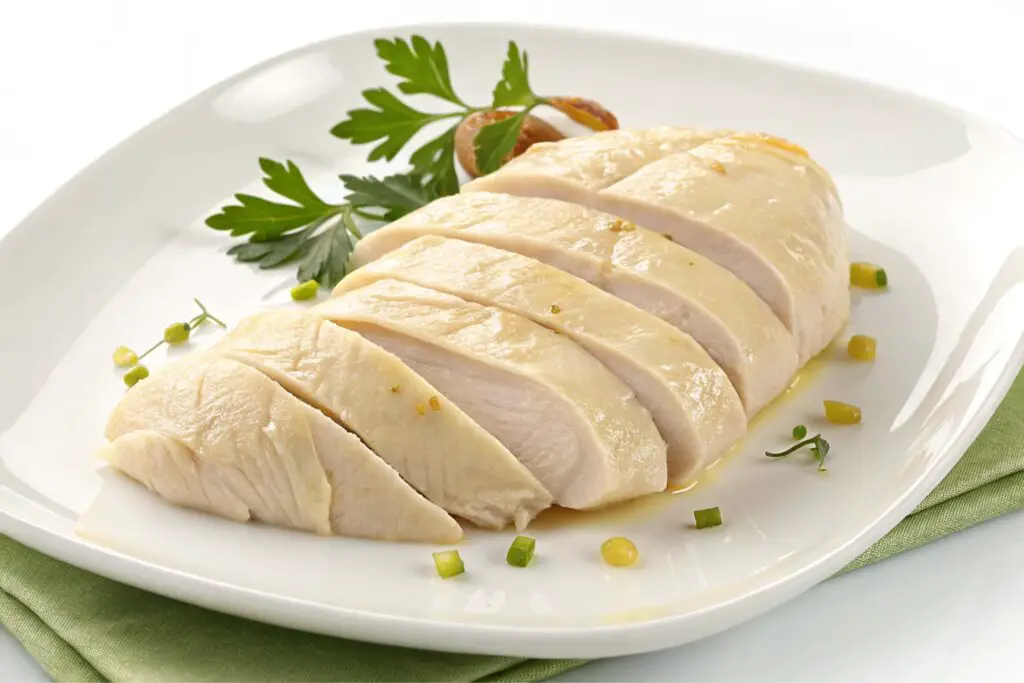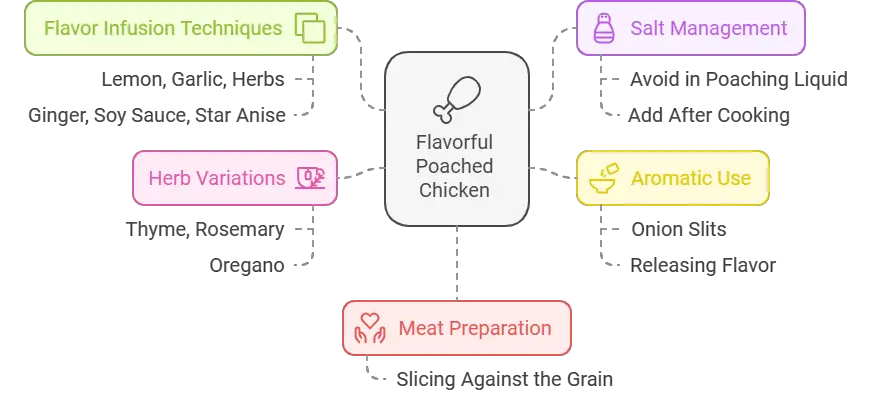want to listen to the recipe ?

Hello everyone! Today, I want to share my love for poached chicken breast. It is a fantastic way to cook chicken that is both healthy and versatile. Poaching results in incredibly tender chicken that is a great source of lean protein. Many people worry about dry, flavorless poached chicken. I’m here to tell you that this guide will help you avoid those issues. I’ll provide all the expert tips you need for perfectly poached chicken every time.
What You’ll Need: Ingredients
Here’s a simple list of what you’ll need to get started:
- Boneless, skinless chicken breasts. The size of the chicken breast will affect cooking time.
- Aromatics and Flavorings:
- Vegetables: One yellow onion with slits cut into it, a few carrots, and a stalk of celery.
- Herbs: One bay leaf, some parsley, dill, thyme, rosemary, or oregano.
- Spices: A few black peppercorns, or some red pepper flakes or star anise.
- Other Aromatics: Garlic cloves and a lemon.
- Liquids: Water, or chicken stock, you could also use white wine or light beer, or soy sauce, fish sauce, coconut milk, and lime juice.
- Optional: Tomato paste and salt. Note that some recipes do not recommend salt during cooking.
The Science of Poaching
Poaching is a cooking method that uses gentle simmering rather than boiling. It’s important to understand what happens to the chicken during this process. The proteins in chicken denature when heated. When you use gentle heat, the chicken becomes tender. High heat can make it tough. Maintaining a consistent temperature is essential for good results. The Maillard reaction, which gives food a browned flavor, does not occur when poaching because the temperature is not high enough. In poaching, heat is transferred through the liquid to the chicken.
Different Methods for Poaching Chicken
I’ll share two methods I use for poaching chicken.

- Method 1: The “Off-Heat” Method
- This is my go-to method because it is easy and reliable.
- First, bring water to a boil in a saucepan.
- Add the chicken breasts to the boiling water and put a lid on the pot.
- Then, immediately take the pot off the stove.
- Let the chicken sit in the hot water for 20 minutes. It’s okay if it sits for up to an hour.
- This method works because the hot water cooks the chicken, and it gradually cools, preventing overcooking.
- This method is forgiving and doesn’t require a thermometer.
- For larger chicken breasts, you can increase the time in the water. If you are at a high altitude, you may need to boil the chicken for a short time before taking it off the heat.
- Remember: Do not add salt to the poaching water when using this method.
- Method 2: The Simmer Method
- In this method, you combine your chicken and flavoring ingredients in a pot.
- Bring the liquid to a simmer, then reduce the heat to low.
- Cook until the chicken is done.
- You must maintain a low heat.
- I use this method when I want more flavor in the poaching liquid.
- To check for doneness, insert a skewer into the thickest part of the breast. The juices should run clear.
Comparison of Methods
Both methods work well. The off-heat method is excellent for preventing overcooked chicken because of the gradual cooling. The simmer method lets the chicken absorb more flavor from the poaching liquid and aromatics. I use the off-heat method when I want a hands-off approach. I use the simmer method when I am adding a variety of vegetables and herbs for a rich broth. Choose the method based on your time, desired results, and preferences.
[woo_product_slider id=”3030″]
Expert Tips for Flavorful Poached Chicken

Here are some of my favorite tips to make your poached chicken more flavorful.
- Flavor Infusion Techniques: I like to add flavor in layers. For example, a combination of lemon, garlic, and herbs gives a great Mediterranean taste. Ginger, soy sauce, and star anise create an Asian flavor. The aromatics will infuse both the chicken and the poaching liquid.
- Don’t Add Salt to the Poaching Liquid: I learned from experience that salt can affect the temperature of the water. This can cause problems when using the off-heat method. I add salt after poaching if needed.
- Onion Slits: I always cut slits in my onion so that more flavor is released into the poaching liquid.
- Herb Variations: You can use so many different combinations of herbs, like thyme, rosemary, or oregano. Use different herbs to create various flavor profiles.
- Slicing Against the Grain: Cutting the chicken against the grain makes it more tender.
Common Poaching Problems
Let’s look at common problems you might encounter.
- Chicken Still Pink: Use a meat thermometer to ensure the chicken reaches 165°F (74°C). If it is not fully cooked, return it to the hot liquid and check again.
- Chicken is Tough: Overcooking can cause tough chicken. Use the off-heat method or monitor the temperature carefully with the simmer method. Also, cooking at too high a temperature will cause tough chicken.
- Adjusting for Altitude: Water boils at a lower temperature at higher altitudes. This requires adjustment to the cooking process. You may need to start by boiling the chicken for one minute before taking it off the heat.
Poaching Chicken from Frozen
It’s best to fully thaw chicken before poaching. If you poach frozen chicken, make sure to cook it thoroughly. Use a thermometer to make sure the internal temperature is safe.
Regional Variations in Poaching
Poaching chicken is a technique used worldwide. Asian methods include ginger, soy sauce, and star anise. European techniques use herbs and white wine. Different cultures use poaching for a variety of purposes.
Utilizing the Poaching Liquid
The poaching liquid is full of flavor and should not be wasted!
- How to Enhance the Broth: I add extra herbs or spices to the poaching liquid. Then, I strain it and store it in the refrigerator for later use.
- Recipes Using Poaching Liquid: I use the poaching liquid as a base for soups. You can use it to make sauces or stews, too.
Serving and Presentation Ideas
I like to slice or shred the poached chicken for salads or sandwiches. I’ll often add a sauce to the chicken, and garnish it with fresh herbs or a squeeze of lemon.
What to Make with Poached Chicken
Poached chicken is incredibly versatile. Here are a few ideas:
- Salads: I love adding poached chicken to salads. You can add any of your favorite dressings.
- Sandwiches and Wraps: Use sliced or diced poached chicken for sandwich or wrap fillings.
- Soups: Add shredded poached chicken to chicken soup or any vegetable soup.
- Pasta and Rice Dishes: Poached chicken is great in pasta or rice dishes.
- Other Dishes: Use it in tacos, burritos, lasagna, and many other dishes.
- Sauces: Serve with sauces such as a honey mustard sauce, a creamy mushroom sauce, or a lemon cream sauce.
Pairing Poached Chicken with Wine
The type of wine to serve with poached chicken depends on its flavor profile. White wine is a safe choice. You might also consider a light red or rosé, depending on the seasoning.
Storage and Reheating
- How to Store Poached Chicken: Store the chicken in an airtight container in the fridge for up to three days. For maximum moisture, store it whole rather than shredded.
- Freezing: You can freeze poached chicken for longer storage. Thaw in the refrigerator, then reheat in a liquid to avoid dryness. Use within 24 hours of defrosting.
Conclusion
Poaching chicken breast is a great way to cook healthy, flavorful meals. I hope you try different methods and flavor combinations. Don’t be afraid to experiment, and please share your experiences!


